In October I was invited onto the Runner’s World UK podcast to talk about “five women who changed running forever”. It’s a great topic for a sports historian, but also quite difficult to choose just five. As Runner’s World magazine is mainly focused on road running up to the marathon distance, I decided to focus on that field. My other selection criterion was that they were women who made an impact on the public awareness of women’s running. Four of the women I selected are marathon pioneers and the other one, Fanny Blankers-Koen, raised the profile of women’s athletics worldwide at a time when women’s running was mainly limited to sprints.
Milestone moments and actions are important, but the history of running has been changed by dozens, hundreds, thousands of women being prepared to take action and by some men being willing to support them.
Fanny Blankers-Koen – athletics superstar
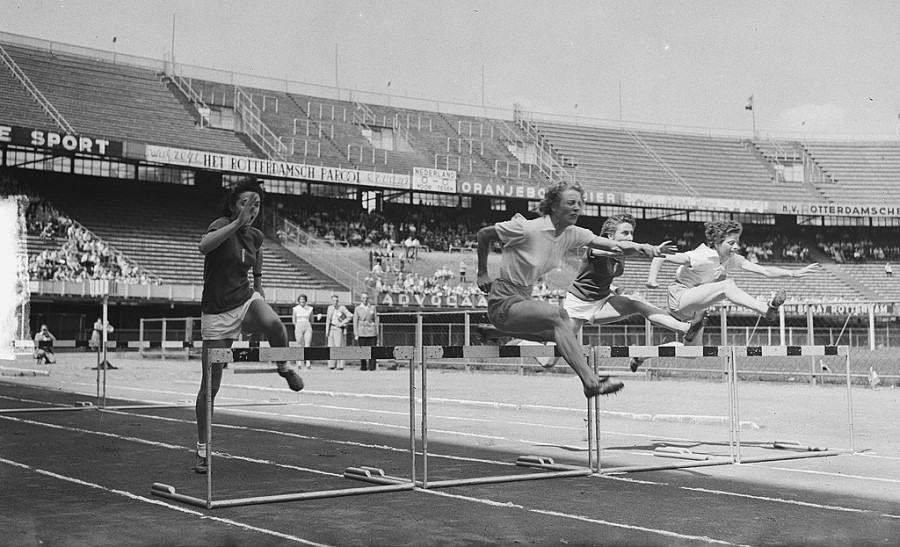
Fanny Blankers-Koen competing in a hurdles race during a Netherlands vs Italy women’s athletics event in Rotterdam, July 1949
Brief Biography
Born Francina Koen on 26th April 1918 in the village of Lage Vuursche in the Netherlands. Married Jan Blankers, her coach, in 1940. Had two children Jantje born 1941 and Fanneke born 1946. Died 2004.
Why include Fanny Blankers-Koen?
Fanny Blankers-Koen showed what women can do in sport and popularised women’s athletics. She became a star at a time when opportunities for women in sport were very limited. There was virtually no road racing for women at this time. On the track women were mainly limited to the sprint distances (100m and 200m) in international competition, whereas men competed at distances up to 10000m.
Blankers-Koen was a multi-talented athlete who set world records in the 100m, 80m hurdles, long jump, high jump and pentathlon, as well as many national records.
She was the biggest star of the 1948 London Olympic games.
In 1999 World Athletics voted Fanny Blankers-Koen the top women’s athlete of the twentieth century.
Early years
Blankers-Koen enjoyed lots of sports as a child and decided to settle on athletics in her late teens when she was told she would have a better chance of qualifying for the Olympics in athletics. Her first competition was in 1935 when she was 17.
Berlin 1936
Blankers-Koen qualified for the Dutch team and competed in 100m relay and long jump but did not win a medal. For her the highlight of the games was getting Jesse Owens’ autograph.
She managed to keep her career going despite the privations the Dutch suffered during the Nazi occupation and even set some world records during the war years in hurdles, high jump, long jump and sprints.
London 1948
The London Olympics were the first event since the Berlin games in 1936. They were known as the austerity games as Great Britain and the rest of Europe were still recovering from the war. When she competed at the London games, Blankers-Koen was thirty and the mother of two children. She received letters telling her she should be at home with her children and people said she was too old.
She won four gold medals and was the first woman to win four Olympic golds and is still the only woman to have won four gold medals at a single games.
- 100m
- 80m hurdles
- 200m
- 4x100m relay
Blankers-Koen might been able to win six medals as she was the world record holder in the long jump and high jump at the time. But athletes were limited to three individual events so she had to choose.
She was called “the flying housewife” in the press and she had to put up with lots of sexist descriptions of her “running as if to save her biscuits from burning in the oven” etc. Whilst her success was celebrated, many journalists chose to put her achievements in the context of her home life and talk about how good she was at fulfilling her domestic duties alongside athletics.
After London
Blankers-Koen was now world famous. In the next few years she travelled to several countries including the USA, Australia and the UK to compete in invitational events. She came to the UK in 1951 during the Festival of Britain and competed at the Hull Festival of Britain athletics competition on 6th August, a Bank Holiday Monday, and at Sedgeley in Staffordshire on 7th August. Her last fixture of the trip was due to be the British Festival Games at White City on Saturday 11th August but it appears she withdrew from the event. She had also competed in Liverpool, Middlesbrough and Glasgow in May and June that year.
Blankers-Koen continued competing until 1955 when she was 37. She won three golds at the 1950 European Championships. Unfortunately she did not do well at the 1952 Helsinki Olympics as she was suffering from a painful boil and pulled out of her races. Her last Dutch championship win was the shotput that year. It was her 58th national title.
After she retired, she was the team leader of the Dutch athletics team from 1958 to 1968.
Kathrine Switzer – marathon pioneer and campaigner
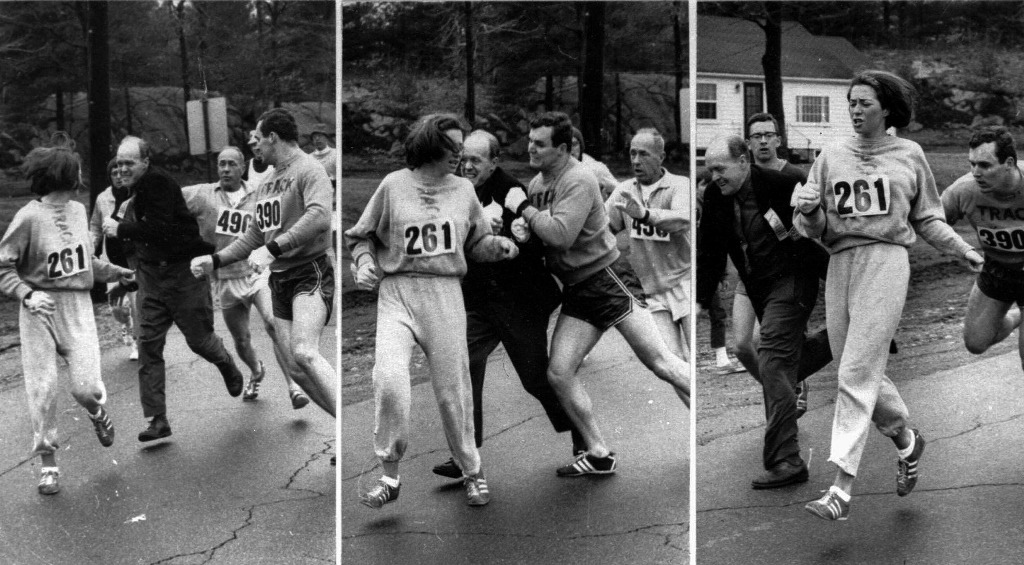
Tom Miller pushes Boston Marathon race director Jock Semple away from Kathrine Switzer
Brief Biography
Born Kathrine Switzer on 5th January 1947 in Amberg, Germany where her father was serving in the US Army. Since 1987, she has been married to Roger Robinson, who competed internationally in athletics for Great Britain and New Zealand.
Why include Kathrine Switzer?
Kathrine Switzer is the first of the four marathon pioneers that I chose. She is one of the most famous endurance runners of the twentieth century – not for her performances but for a milestone event. In 1967 when marathon running was reserved for men, she managed to get an entry for the Boston Marathon, one of the longest-established marathon races. There was a press truck at the race and, once they heard a woman was in the race, the photographers wanted to take pictures of her. This led to a famous series of photographs showing the moment when the enraged Race Director, Jock Semple, realised that a woman had entered the race and tried to push her off the course, only to be pushed away himself by Kathrine Switzer’s boyfriend, Tom Miller.
These dramatic shots still shock people today. and the ensuing media coverage made this a defining moment in women’s struggle to be admitted to the all-male preserve of distance running.
Switzer went on to devise and run the Avon International Women’s Running Circuit which held women-only races in countries around the world. She was one of the people who made the case for the women’s marathon to be included in the Olympic Games.
Early years
Switzer started running a mile a day aged 12 because she wanted to get into the school hockey team. Running quickly became an important part of her life:
It was the running every day that gave me a sense of empowerment. It gave me a victory under my belt every day that nobody could take away from me and to grow up with that is a very powerful thing.
In 1967, Kathrine Switzer was a 20-year-old journalism student at Syracuse University, New York. She started training with the men’s cross country coach, Arnie Briggs, and persuaded him that she would be able to complete the marathon distance. She had run 31 miles in training. Women were still excluded from distance running. The longest permitted road distance for women in the USA was 1.5 miles and the longest distance in the Olympics programme was 800m.
Boston Marathon 1967
In 1966 Bobbi (Roberta) Gibb had applied to enter the Boston Marathon but had been turned down on the grounds that women were not physiologically capable of running marathon distances. She ran the race anyway, hiding in the bushes and joining the race as it started. Her time was not officially recorded but was around 3 hours 20 minutes, attracting attention from the press. She was said to have finished ahead of two-thirds of the men.
In 1967, Switzer registered for the race as “K.V.Switzer” which was the way she usually wrote her name and she got a male runner to pick up her numbers. When Jock Semple, the Race Director, realised that she was in the race, he ran up behind her and tried to rip her race numbers off. Switzer was running with Arnie Briggs, another male student from the university and her boyfriend, Tom Miller, a hammer thrower. It was Miller who knocked Semple over.
It was a frightening experience and Kathrine could easily have given up at this point but it made her more determined to finish the race to show that women could be serious runners. Switzer realised that what had happened to her had a wider and deeper significance. She made a commitment to enabling other women to race.
More marathons
Kathrine Switzer continued to train for and run marathons in the early days of elite women’s competition, several of them unofficially. When the Boston Marathon finally officially admitted women in 1972, she was there along with seven other women who all completed the race. She ran the New York City Marathon four times, winning it in 1974. Eventually she decided that she wanted to concentrate on her career and her campaign, and this meant giving up training at an elite level.
The Avon International Women’s Running Circuit
Kathrine went on to campaign for women’s right to compete in distance races. Working with her employer, Avon Cosmetics, as sponsor, in 1977 she established Avon International Running Circuit, a series of women-only races. Four hundred races took place in 27 countries across the world. They included seven international women’s marathons held between 1978 and 1984. These marathons attracted top female marathoners from several countries and played a role in getting the women’s marathon included in the Olympics. (More about the 1980 London International Women’s Marathon.)
After 1984
Now 75, Switzer is still running races and in 2017 she ran the Boston Marathon again on the fiftieth anniversary of her first race there.
In 2015, Kathrine established the 261 Fearless Foundation, a global non-profit network that encourages women to run and and sets up running groups. 261 was her bib number at Boston.
Joan Benoit – Olympic marathon winner
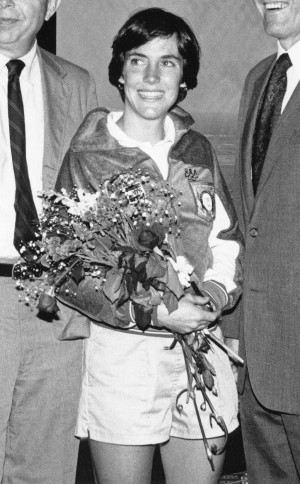
Brief Biography
Born 16th May 1957 in Cape Elizabeth, Maine. Married Scott Samuelson in September 1984 and is now known as Joan Benoit-Samuelson. They have two children: Abby and Anders.
Why include Joan Benoit?
Joan Benoit will be remembered forever as the winner of the first Olympic Women’s Marathon at Los Angeles in 1984. She had overcome a serious injury to compete and was not expected to win. She ran into the Memorial Coliseum stadium in her silver-grey USA vest and shorts, and the white cotton cap she’d been wearing during the race. The second and third runners were nearly a minute and a half behind. Greeted by tumultuous applause and cheering from the crowd of 90,000 spectators, she took off her cap waving it triumphantly as she completed a lap of the track, crossing the line with her arms aloft. It was a huge milestone in women’s distance running.
Benoit is still running today and setting age group records.
Early life
Benoit’s dreams were initially to be a downhill skier. It was only when she broke her leg as a teenager that she took up running as part of her rehabilitation. She would run on her own around an abandoned army base, near her home in Fort Williams, Maine. She excelled in athletics at college, running track and cross country and got an athletics scholarship.
Running marathons
Benoit ran the Boston Marathon aged 21 in 1979 and won the race, setting a new American record too (2:35:15). In 1980, she ran in the Avon London International Women’s Marathon organised by Kathrine Switzer, finishing fourth.
She set half marathon world records twice in 1981 and then again in 1983 and 1984.
She broke the marathon world record at Boston in 1983, running 2:22:43 (a time which stood for two years). The record she broke had been set by Grete Waitz of Norway at the London Marathon the day before.
The 1984 Los Angeles Olympics marathon
In March 1984, Benoit injured her knee severely during a 20-mile training run, forcing her to undergo arthroscopic knee surgery just 17 days before the United States Olympic Women’s Marathon Trials on 12th May. She recovered from the surgery much more quickly than expected, and won the trials, securing her place in the first Olympic women’s marathon.
On 5th August 1984, the race favourite was Grete Waitz. But Benoit surprised commentators by taking the pace on after just a few miles. She stayed ahead and left the field behind. She ran into the Memorial Coliseum on her own, winning the race by (2:24:52), more than a minute ahead of Grete.
After 1984
In 1985, Benoit won the Chicago Marathon in her personal best time of 2:21:21. This stood as the course record for 32 years and an American record for 18 years.
Despite injuries, Benoit has continued competing in road races as an amateur. In 2019, Benoit ran the Boston Marathon again, forty years after her 1979 win, finishing in 3:04:00, within thirty minutes of her winning time, and winning her age v60 category.
At this year’s London Marathon Benoit won the women’s v65 age category in 3:20:20, a new American age group record. She finished just behind her daughter Abby. Benoit already holds the v60 American age group record for the marathon.
Joan Benoit is aiming to complete the Abbott World Marathon Majors series of races, made up of marathons in New York City, Chicago, Boston, London, Berlin and Tokyo. She just has Tokyo left to go to get the Six Star medal given to everyone who completes all six races.
Tegla Loroupe – African marathon pioneer
Brief biography
Born 9th May 1973 in a village in West Pokot District in the Rift Valley, Kenya.
Why include Tegla Loroupe?
On 6th November 1994, aged 21, Tegla Loroupe became the first black African woman to win a major marathon when she ran the New York Marathon in 2:27:37. She was also the first black African woman to break the world record which she did twice in 1998 and 1999. From humble beginnings, she became a role model to many women and girls and paved the way for the rise of Kenyan and African women in distance running.
I fought my way through not for myself, but for other women who couldn’t believe in themselves. For them to see that there was someone who has been there fighting for them, to make a difference.
Loroupe has dedicated her life to harnessing the power of sport to promote peace.
Early years
Loroupe spent her childhood working fields, tending cattle and looking after younger brothers and sisters. When she started school at the age of six, Loroupe had to run ten kilometres to and from school every day. She became aware of her potential when she beat much older students in races over 800m and 1500m.
She decided to pursue a career as a runner but received little support. Athletics Kenya thought she was too small and too thin to be a successful athlete. This changed after she won a prestigious cross country barefoot race in 1988, aged 14 or 15. Loroupe began to train to compete internationally the following year, earning her first pair of running shoes in 1989. She competed in the 1989 (aged 15) and 1990 (aged 16) World Cross Country Junior Championships. In 1994, she won the 10000m race at the Goodwill Games, running barefoot.
Marathon world records
Loroupe became the first black African woman to win a major marathon when she won the 1994 New York Marathon. She won New York again in 1995, Rotterdam in 1997, 1998 and 1999, Berlin in 1999 and London in 2000. Her last marathon win was Leipzig in 2004.
Loroupe set the marathon world record twice. First in Rotterdam in 1998 (2:20:47) and then the following year in Berlin (2:20:43). She held the record for 3 years. She also won the World Half Marathon Championships in 3 consecutive years 1997-1999.
She finished 6th in the 10000m at the 1996 Atlanta Olympics and won bronze at 10000m at the 1995 and 1999 World Athletics Championships.
At the 2000 Sydney Olympics, Loroupe competed in the 10000m and the marathon. She was the favourite in the marathon but suffered violent food poisoning the night before the race and could only finish 13th. Despite this, she ran the 10000m the next day finishing 5th. She ran both races barefoot and said this was out of a sense of duty to people in her home country who saw her as a symbol of hope.
At the 2005 World Championships in Helsinki, Loroupe ran the marathon but only finished 40th.
Peace maker
Loroupe has been able to use her running success as a platform to make not only a wider contribution to the sport of running, but also to build trust between communities in Kenya, empower women and girls and create opportunities for athletes, including refugee athletes, to train. She founded the Tegla Loroupe Peace Foundation in 2003. The same year, she started the Tegla Loroupe Peace 10k race held in West Pokot. Its aim was to promote unity between rival tribes in the area. The first race attracted thousands of competitors and it is still taking place.
In 2006, she was named a United Nations Goodwill Ambassador of Sport. She was also an International Sports Ambassador for the IAAF (now World Athletics) and for UNICEF.
Loroupe set up a training camp for refugee athletes in Ngong near Nairobi. She was instrumental in creating the first-ever refugee Olympic team for the 2016 Olympics in Rio de Janeiro. She was the team’s Chef de Mission and had the same role for the Tokyo Olympics.
In October 2016 Loroupe was awarded United Nations Person of the Year.
Paula Radcliffe – transforming the marathon
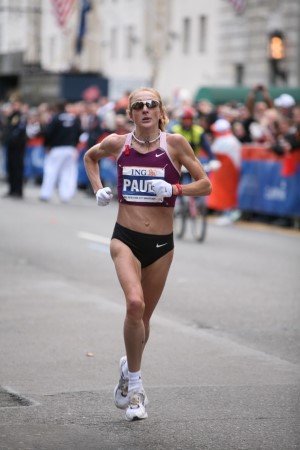
Brief biography
Born 17th December 1973. Married Gary Lough in 2001. They have two children, Isla born in 2007 and Raphael born in 2010.
Why include Paula Radcliffe?
On 13th October 2002, Paula Radcliffe set a new record of 2:17:18 at the Chicago Marathon. She reduced the record by 1 minute 29 seconds, and 6 months later she was able to run nearly two minutes faster (2:15:25) at the London Marathon. She held the world record for 17 years to the day until Kenyan Brigid Kosgei broke it at Chicago in 2019 (2:14:04). The longest time any other woman has held the record was Ingrid Kristiansen of Norway who held it for two days short of thirteen years from 1985 to 1998 when Tegla Loroupe broke her record.
Her mark was unbeatable for so long – it was a challenge to all the women who followed her.
Early years
Radcliffe joined Bedford and County Athletics Club at the age of 11 or 12, and it quickly became evident that she was a talented runner. She competed at the World Cross Country Junior Championships at 16 and won the World Junior Cross-country title in 1992 aged 18. After graduating from Loughborough University in 1996, she devoted herself full-time to running.
Track and cross country success
Radcliffe competed internationally with success at the 3000m, 5000m and 10000m from 1992 to 2005.
- 1999 World Championships, 10,000m silver
- 2002 Commonwealth Games, 5000m gold
- 2002 European Championships, 10,000m gold
She won the World Cross Country Championships in 2001 and 2002 and the European Cross Country Championships in 2003.
The move to roads
In 2000, Radcliffe won the World Half Marathon Championships which she won again in 2001 and 2003.
In 2001 she began to focus her training on the marathon. She won her first marathon, the 2002 London Marathon with a time of 2:18:56. Later that year she competed in the Chicago Marathon. Her winning time of 2:17:18 cut 89 seconds from the women’s world record for the marathon and represented the biggest improvement in the event in more than 17 years.
Sixth months later, on 13th April 2003, she brought her world record time down to 2:15:25 at London.
In February 2003, she had set a 10k (road) world record of 30:21 in Puerto Rico.
Radcliffe won the London Marathon again in 2005 and she won the New York Marathon three times (2004, 2007, 2008). The 2007 win came nine months after giving birth to her first child, Isla.
On 14th August 2005, she won the World Championships Marathon in Helsinki in 2:20:57.
Olympics
Despite having the opportunity to compete at five Olympics, Radcliffe was unable to fulfil her potential.
- 1996 Atlanta – 5000m – 5th
- 2000 Sydney – 10000m – 4th in a new British record
- 2004 Athens – marathon & 10000m– withdrew
- 2008 Beijing – marathon – 23rd
Retirement
At the Beijing Olympics Radcliffe had a stress fracture. She was unable to compete in the 2012 London Olympics because of a foot injury. In 2015 she announced that she would be retiring after that year’s London Marathon. She finished the race in 2:36:55, first woman in the open (non-elite) field. Radcliffe remains the only British woman to have run under 2 hours 20 minutes.
Inspiration
Fanny Blankers-Koen, Kathrine Switzer, Joan Benoit, Tegla Loroupe and Paula Radcliffe showed what it was possible for women to do and how strong women could be. Blankers-Koen, Switzer and Loroupe competed despite prevailing social conventions that this sport was not for women, or not for women like them. Benoit’s win at the Los Angeles Olympics is an iconic moment in women’s running history. Radcliffe lifted women’s performance to a new level. Runners today continue to be inspired by them.
Which five women would you include on your list?
Omissions
In the podcast interview, Rick Pearson asked me who I had would have liked to include in this list but had had to leave out. My immediate answer was Dale Greig, the Scottish marathon pioneer who broke the rules and ran the Isle of Wight Marathon in 1964. I have spent a lot of time researching Greig and believe her story should be better known.
Other women who could easily have been on my list:
- Violet Piercy who ran long distances on the roads in the 1920s and 1930s when it was completely unheard of for women
- Alice Milliat who organised the first international athletics competitions for women in the 1920s and pressed for the inclusion of women’s events in the Olympic Games
- Diane Leather, the first woman to run a sub-5-minute mile at a time when the distance was not even included in international competition for women
- Marea Hartman, Honorary Secretary of the Women’s Amateur Athletic Association, who in her role of Chairman of the Women’s Commission of the IAAF was instrumental in getting longer distances for women and more events included in international competition
- Jacqueline Hansen, a marathon pioneer who set the world record twice and then led the International Runners Committee’s campaign to get longer distances for women recognised by the IAAF and included in the World Championships and the Olympics
My Twitter friends The Real Cross Country (@Real_XC) came up with their own list: Alice Milliat, Gladys Lunn, Diane Leather, Doris Brown Heritage, Grete Waitz. Amby Burfoot’s book, “First Ladies of Running”, has 22 profiles of mainly American women who changed running and a chapter on “More First Ladies” which includes brief profiles of many more runners.
Whilst we are naturally drawn to stories of individuals and to those women who were leaders working to bring about change, there are many unknown or unnamed women who played a part in changing running forever.
Sources
The Austerity Olympics, Janie Hampton, Aurum Press Limited, London, 2008
Marathon Woman, Kathrine Switzer, Da Capo Press, Cambridge, Massachussets, 2009
First Ladies of Running, Amby Burfoot, Rodale Inc, New York, 2016
Wikipedia for biographical details
World Athletics athlete profiles for race performances
Lewis and Blankers-Koen voted top athletes of the 20th century , World Athletics, 22nd November 1999
Keen Competition in British Games, Birmingham Post, 13th August 1951
Thomas Hurst gave me details of the locations Fanny Blankers-Koen visited in the UK in the 1950s.
The Dead Ladies Show podcast featured an entertaining talk about Fanny Blankers-Koen and her housewife image in 2017
No stopping Loroupe in her crusade for peace in sport, World Athletics, 6th April 2021
Photographic Credits
Banner photograph: Benoit Breezes in the Marathon, Philadelphia Enquirer, Monday 6th August 1984, Newspapers.com
Fanny hurdling, Ben Merk / Anefo, CC0, via Wikimedia Commons, 24th July 1949, Netherlands vs Italy women, at Rotterdam, Dutch National Archives, Nationaal Archief
Series of photos of Boston Marathon 1967: AP Images
Joan Benoit, in the Mayor’s office, Boston, c1984, City of Boston Archives from West Roxbury, United States, CC BY 2.0, via Wikimedia Commons
Tegla Loroupe winning the London Marathonon 16th April 2000 , Getty Images embed
Paula Radcliffe, New York Marathon 2008, 25th November, fergie lancealot, CC BY 2.0, via Wikimedia Commons
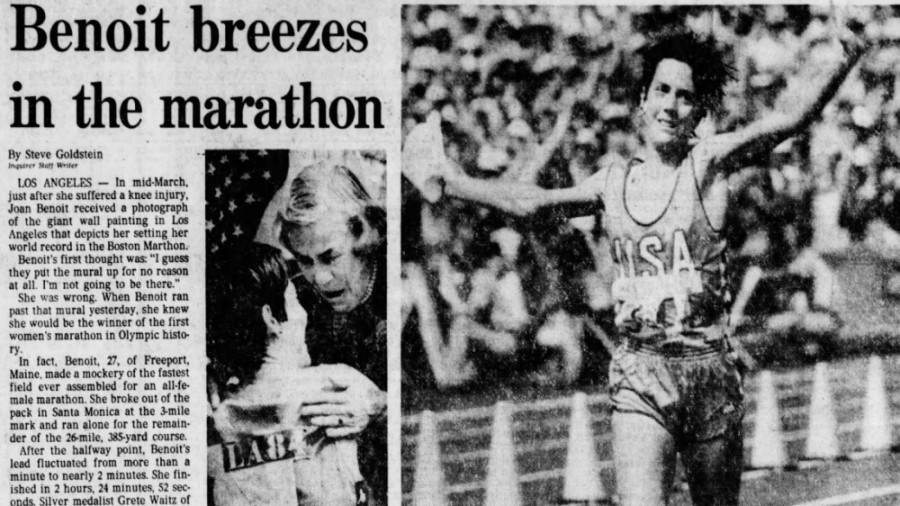

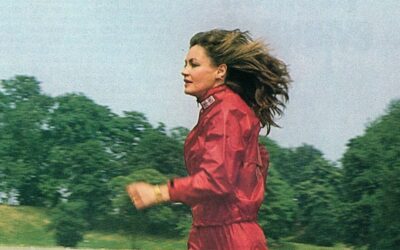
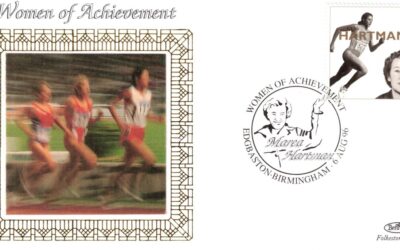
Ingrid Kristiansen held the marathon record between 1985 and 1998, much longer than Grete Waitz.
I believe Paula Radcliffe was a fan.
Hello Ron, thank you for pointing out my error. I have corrected that in the article. Katie